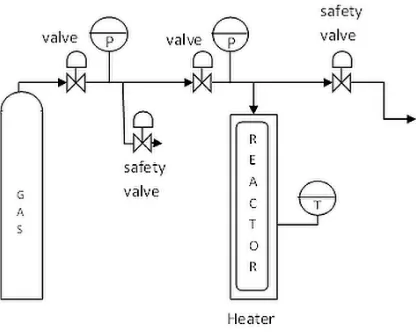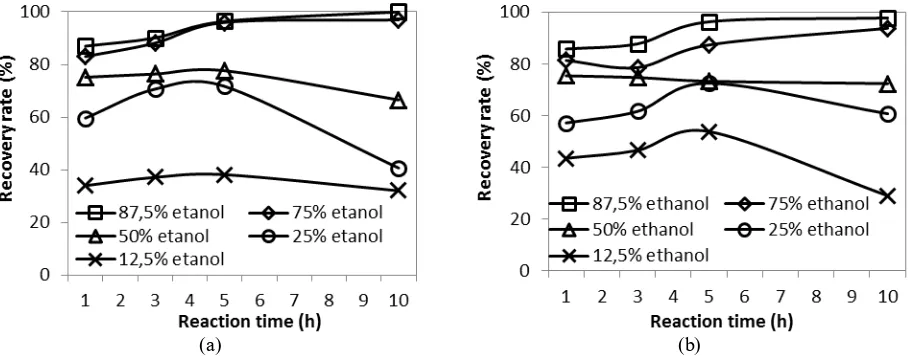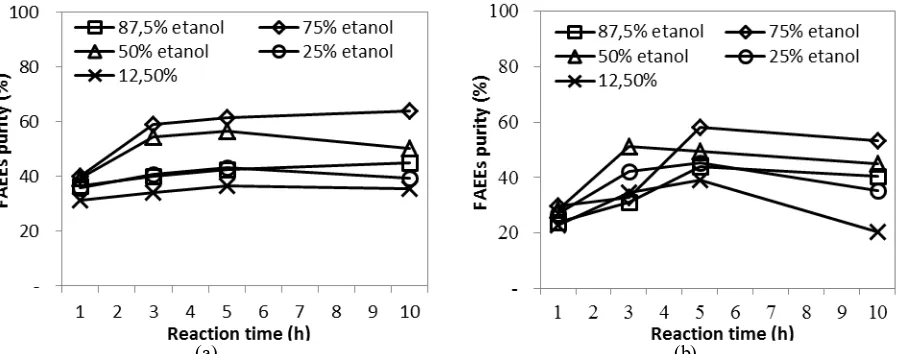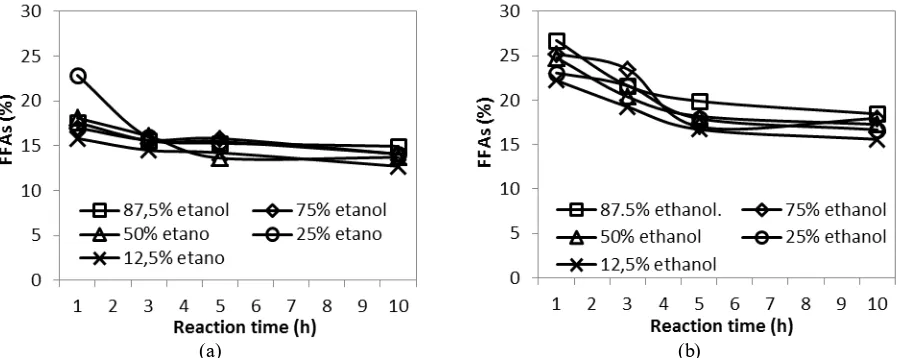Catalyst-free ethyl biodiesel production from rice bran under subcritical condition
Siti Zullaikah, Riza Afifudin, and Rizky AmaliaCitation: AIP Conference Proceedings1699, 030022 (2015); doi: 10.1063/1.4938307 View online: http://dx.doi.org/10.1063/1.4938307
View Table of Contents: http://aip.scitation.org/toc/apc/1699/1
Catalyst-free Ethyl Biodiesel Production from Rice Bran
under Subcritical Condition
Siti Zullaikah
a), Riza Afifudin and Rizky Amalia
Department of Chemical Engineering
Institut Teknologi Sepuluh Nopember, Kampus ITS Keputih, Sukolilo, Surabaya 60111 Indonesia
a)Corresponding author: szulle@chem-eng.its.ac.id
Abstract. In-situ ethyl biodiesel production from rice bran under subcritical water and ethanol with no catalyst was employed. This process is environmentally friendly and is very flexible in term of feedstock utilization since it can handle relatively high moisture and free fatty acids (FFAs) contents. In addition, the alcohol, i.e. bioethanol, is a non-toxic, biodegradable, and green raw material when produced from non-edible biomass residues, leading to a 100% renewable biodiesel. The fatty acid ethyl esters (FAEEs, ethyl biodiesel) are better than fatty acid methyl esters (FAMEs, methyl biodiesel) in terms of fuel properties, including cetane number, oxidation stability and cold flow properties. The influences of the operating variables such as reaction time (1 – 10 h), ethanol concentration (12.5 – 87.5%), and pressurizing gas (N2 and CO2) on the ethyl biodiesel yield and purity have been investigated systematically while the temperature and pressure were kept constant at 200 °C and 40 bar. The optimum results were obtained at 5 h reaction time and 75% ethanol concentration using CO2 as compressing gas. Ethyl biodiesel yield and purity of 58.78% and 61.35%, respectively, were obtained using rice bran with initial FFAs content of 37.64%. FFAs level was reduced to 14.22% with crude ethyl biodiesel recovery of 95.98%. Increasing the reaction time up to 10 h only increased the yield and purity by only about 3%. Under N2 atmosphere and at the same operating conditions (5h and 75% ethanol), ethyl biodiesel yield and purity decreased to 54.63% and 58.07%, respectively, while FFAs level was increased to 17.93% and crude ethyl biodiesel recovery decreased to 87.32%.
Keywords: Ethyl biodiesel; rice bran; in situ; subcritical water; subcritical ethanol.
INTRODUCTION
As a country with rice as staple food, Indonesia has abundant quantity of rice bran which is a by-product of rice milling. Rice bran is naturally rich in oil, polysaccharide, protein, fiber, vitamin and antioxidant; however it is traditionally only utilized as low value cattle food. The oil content in rice bran is affected by the degree of milling, but it is typically around 10 – 25% [1 – 3]. This high oil content and the fact that the oil is rather unsuitable for human consumption due to high free fatty acids (FFAs) content [4] make rice bran suitable for biodiesel feedstock.
Traditionally, biodiesel is produced by reacting oil and alcohol with strong base as a catalyst. However, this process requires less than 1% FFAs content in feedstock [5], otherwise soap will be formed making the separation process complicated. Therefore, this process is unsuitable for crude rice bran oil (RBO) with high FFAs content. Oil with high FFAs content can be converted into biodiesel under acidic condition, but the reaction rate is quite low [2]. The transesterification reaction can also be catalyzed by enzyme; however the high cost of enzyme makes this route uneconomical [6].
Recently, several researchers have reported promising non-catalytic biodiesel production under subcritical alcohol-water condition using various feedstocks, e.g. soybean oil [8], algae [9] and activated sludge [10]. Subcritical water is defined as hot water under critical temperature (100 – 374 °C) and pressure high enough to maintain water at liquid state. Subcritical water has lower dielectric constant than that at ambient temperature, i.e. 27 at 250 °C and 80 at room temperature [8], and therefore can be used as an alternative solvent to extract organic compounds. Besides that, the dissociation constant of water (kw) at subcritical condition is higher than that at
ambient condition, i.e. 10-12 at subcritical condition and 10-14 at ambient condition [11]. This will enhance the
hydrolysis and transesterification reactions due to higher H+ and OH- concentrations.
Subcritical water can be utilized to extract oil and other components in rice bran, such as polysaccharide, protein, vitamin and antioxidant. Using a biorefinery approach to maximize the value added of rice bran, the protein, vitamin and antioxidant can be isolated, while the polysaccharide can be employed as fermentation feedstock to produce ethanol. Biodiesel can also be produced simultaneously during extraction process by introducing alcohol into subcritical water. Although methanol is usually used in biodiesel production due to faster reaction rate and higher yield, ethanol can also be used as an alternative. The addition of ethanol into subcritical water can increase the recovery rate of non-polar compounds, such as oil, vitamin and antioxidant since the polarity of ethanol is closer to those of organic compounds than that of water.
Due to time limitation, only the production of biodiesel is reported in this work, while the isolation of other valuable compounds will be investigated in the future. The objective of this work is to investigate the effects of reaction time, ethanol concentration, and compressing gas type (CO2 and N2) on the in-situ production of ethyl
biodiesel (fatty acid ethyl esters, FAEEs) from rice bran using subcritical ethanol/water mixture. The experiments were carried out at constant temperature and pressure, i.e. 200 °C and 4 MPa.
EXPERIMENTAL
Materials
Rice bran with 12.9 ± 0.1% moisture and 14.9 ± 0.2% oil contents was obtained from local rice mill (Lamongan, East Java, Indonesia). It is from IR 64 rice variety. The moisture content was determined by drying the rice bran while the oil content was determined by Soxhlet extraction using n-hexane as solvent for 5 hours. The free fatty acids (FFAs) in the rice bran oil were determined by using titration method according to a modified AOCS method [12] and it was found to be 37.6 ± 0.2%.
All chemicals were analytical grades and purchased from Brataco (Indonesia). The compressing gasses (CO2 and
N2) were supplied by Genta Prima Gas (Indonesia). Distilled water was used in this work.
In-situ production of ethyl biodiesel
Figure 1. Schematic diagram of experimental setup
Rice bran (5 g) was mixed with ethanol/water mixture (40 ml) in the reactor. The ethanol concentration was varied from 12.5 – 87.5%. The temperature was then raised to 200 °C by using an electric heater while the pressure was increased to 40 bar using either CO2 or N2 as compressing gas. After reaching the desired values, the
temperature and pressure were maintained for a predetermined reaction time (1 – 8 h). The reaction was stop by quenching the reactor into an iced water bath to decrease both temperature and pressure to 5 – 15 °C and less than 5 bar, respectively. The needle valve was then released to reduce the pressure to atmospheric.
After that, the solid and liquid phases were separated. The liquid phase was mixed with hexane and stirred at 100 – 300 rpm for 10 minutes. After settled for 10 minutes, the hexane phase (top phase) was collected. The bottom phase was remixed with hexane and this procedure was repeated five times. The solid phase was also mixed with hexane, stirred at 100 – 300 rpm for 10 minutes and then the solid phase was separated from the hexane phase using filter paper. This procedure was also repeated five times. Subsequently, the hexane was evaporated in a rotary evaporator to recover the oil. The rice bran oil (RBO) obtained using this method was compared to that obtained using Soxhlet extraction with hexane to determine the recovery rate.
Analysis of FFAs
The FFAs content was analyzed using titration method according to modified AOCS official method Ca 5a-40 as reported by Rukunudin et al. [12]. Crude ethyl biodiesel (0.01 g) was mixed with 96% ethanol (0.107 ml) and pp indicator (2 drops) in an Erlenmeyer flask. The mixture was heated to 50 °C and then titrated using 0.0044 N NaOH solution until the mixture turned to pink. The FFAs content was determined according to the following equation:
%FFAs = [(Volume NaOH x Normality of NaOH x 28.2)/sample weight] x 100% (1)
Analysis of ethyl biodiesel content
RESULTS AND DISCUSSION
The effects of reaction time and ethanol concentration on the recovery rate of crude ethyl biodiesel under CO2
and N2 atmospheres are shown in Fig. 2(a) and (b), respectively. The experimental results show that the recovery
rate is not significantly affected by the type of compressing gas used. In both cases, the recovery rate increases with increasing ethanol concentration and longer reaction time up to 5 h. Higher ethanol concentration is expected to increase the recovery rate since the polarity of ethanol is closer to that of rice bran oil than that of water and consequently, the extraction rate increases with higher ethanol concentration. At ethanol concentration lower than 75%, the recovery rate decreases when the reaction time is extended to 10 h, while at 75% and 87.5% ethanol concentrations, the recovery rates increase slightly. Under CO2 atmosphere, the recovery rates at 87.5% ethanol
concentration after 5 and 10 h reaction times are 96% and 100%, respectively. Therefore, the optimum reaction time can be considered to be 5 h.
The effects of reaction time and ethanol concentration on the ethyl biodiesel (FAEEs) purity in the crude biodiesel under CO2 atmosphere is shown in Fig. 3(a). FAEEs purities at different ethanol concentrations increase
with reaction time up to 5 h and then they are practically constant with longer reaction time. These results confirm that the optimum reaction time is 5 h. FAEEs purity also increases with increasing ethanol concentration up to 75%. Higher ethanol concentration increases the rates of both transesterification and esterification reactions as well as pushes the equilibrium toward the formation of FAEEs. However, increasing the ethanol concentration to 87.5% decreases FAEEs purity significantly. This may suggest that water has an important role in the formation of FAEEs under subcritical ethanol/water mixture. Saka and Minami [13] reported that the hydrolysis reaction is about four times faster than transesterification reaction, while the esterification of fatty acids was about an order of magnitude faster than transesterification reaction. Therefore, water is required to hydrolyze triglycerides into FFAs which subsequently react with ethanol to form FAEEs. This could be the preferred reaction mechanism under subcritical ethanol/water condition. These results also indicate that the presence of both water and FFAs is not a problem in subcritical ethanol/water method. Based on the experimental results, the optimum ethanol concentration is found to be 75%.
The behaviors under N2 atmosphere show similar trend (Fig. 3(b)), however the FAEEs content is higher under
CO2 atmosphere at the same ethanol concentration. CO2 can react with water to form carbonic acid making the
solvent (ethanol/water mixture) acidic. Since hydrolysis, esterification and transesterification reactions are catalyzed by H+, the reaction rates are faster under CO
2 atmosphere.
(a) (b)
(a) (b)
Figure 3. Effects of reaction time and ethanol concentration on the purity of ethyl biodiesel (FAEEs) (a) under CO2
atmosphere and (b) under N2 atmosphere. Operating conditions: T = 200 °C, P = 40 bar.
Figures 4(a) and (b) shows the FAEEs yields under CO2 and N2 atmospheres, respectively. FAEEs yield is
defined as the ratio of FAEEs weight in the crude biodiesel to total oil weight in rice bran (obtained using Soxhlet extractor with hexane). FAEEs yield under CO2 atmosphere is higher than that under N2 atmosphere in accordance
with higher FAEEs content under CO2 atmosphere. While the maximum FAEEs yield of 62% is obtained after 10 h
reaction time at 75% ethanol concentration (under CO2 atmosphere), FAEEs yield at the optimum reaction time of 5
h and 75% ethanol concentration is slightly lower, i.e. 59%.
(a) (b)
Figure 4. Effects of reaction time and ethanol concentration on the yield of ethyl biodiesel (FAEEs) (a) under CO2
atmosphere and (b) under N2 atmosphere. Operating conditions: T = 200 °C, P = 40 bar.
One of the main impurities in crude biodiesel is FFAs. FFAs contents under CO2 and N2 atmospheres are shown
in Fig. 5(a) and (b), respectively. The experimental data show that FFAs content decreases with longer reaction time but ethanol concentration has little effect. FFAs contents under CO2 atmosphere at 1 and 10 h reaction times are 15 –
23% and 12 – 15%, respectively, at different ethanol concentrations. Under N2 atmosphere, the decrease in FFAs
contents is more pronounce in the first 5 h of reaction, but the final FFAs contents are slightly higher than those under CO2 atmosphere, i.e. about 15 – 18.5%. This is expected since esterification of FFAs is catalyzed by acid and
CO2 atmosphere can make the solvent more acidic.
even after 10 h reaction time, not all FFAs can be converted into FAEEs. This is due to the presence of water in the system that hydrolyzes FAEEs into FFAs and ethanol. It is the reverse reaction of FFAs esterification.
(a) (b)
Figure 5. Effects of reaction time and ethanol concentration on FFAs content (a) under CO2 atmosphere and (b)
under N2 atmosphere. Operating conditions: T = 200 °C, P = 40 bar.
CONCLUSIONS
The effects of reaction time, ethanol concentration and compressing gas type on direct production of ethyl biodiesel (FAEEs) from rice bran using subcritical ethanol/water mixture have been investigated. It was found that crude ethyl biodiesel recovery rate, FAEEs content, FAEEs yield increased with reaction time, while FFAs content decreased. The optimum reaction time was found to be 5 h since longer reaction time up to 10 h only slightly increased the yield. The use of CO2 as compressing gas led to higher FAEEs content and yield but lower FFAs
content than those under N2 atmosphere. This is because CO2 can react with water to form carbonic acid making the
solvent more acidic making the reactions faster since they are catalyzed by H+. However, the crude ethyl biodiesel
was not significantly affected by the type of compressing gas used.
The crude ethyl biodiesel recovery rate increased with increasing ethanol concentration since the polarity of ethanol is closer to that of rice bran oil than that of water and therefore higher ethanol concentration increased oil extraction rate. FAEEs content and yield also increased with ethanol concentration up to 75%. Higher ethanol concentration increased both transesterification of oil and esterification of FFAs as well as pushes the equilibrium toward the formation of FAEEs. On the other hand, the FFAs content was not significantly affected by ethanol concentration.
The experimental results showed that subcritical ethanol/water mixture can be used to produce ethyl biodiesel from feedstock with high moisture and FFAs contents without any pretreatment. Besides that, this method is also catalyst-free. Therefore, this experiment can provide an efficient and environmentally friendly method to produce biodiesel from an abundant rice milling by-product, i.e. rice bran which has low economic value.
ACKNOWLEDGMENTS
A financial support from Institut Teknologi Sepuluh Nopember (ITS) is greatly appreciated.
REFERENCES
5. M. Berrios, J. Siles, M. Martin and A. Martin, Fuel86, 2383 – 2388 (2007).
6. A. Gog, M. Roman, M. Tosa, C. Paizs and F. D. Irimie, Renew. Energ.39, 10 – 16 (2012). 7. S. Saka and D. Kusdiana, Fuel80, 225 – 231 (2001).
8. Y. H. Ju, L. H. Huynh, Y. A. Tsigie, and Q. P. Ho, Fuel105, 266–271 (2012).
9. Y. A. Tsigie, L. H. Huynh, S. Ismadji, A. M. Engida and Y. H. Ju, Chem. Eng. J. 213, 104 – 108 (2012). 10. L. H. Huynh, P. L. T. Nguyen, Q. P. Ho, and Y. H. Ju, Bioresource Technol. 123,112-116 (2012). 11. P. Kritzer and E. Dinjus, Chem. Eng. J. 83, 207 – 214 (2001).
12. I. H. Rukunudin, P. J. White, C. J. Bern and T. B. Bailey, JAOCS 75, 5 (1998).



